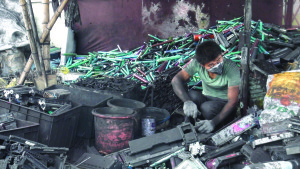Workers set to lose their jobs at a General Electric plant in the US fear serious diseases linked to their exposure to polychlorinated biphenyls (PCBs) could hit them later in life.
The union representing the workers at the GE Fort Edward plant is citing concerns over exposure to toxic PCBs – used in manufacture of capacitors at the plant – in pressing the company to pay for health testing after workers lose their jobs.
But the Albany Times Union reports the company, which is closing the plant, is refusing the request. A high-ranking GE executive also told the union there is “no credible evidence” that PCBs cause cancer or other serious illness, a stance that puts the company at odds with federal and international health agencies that for years have labelled the chemical as a likely human carcinogen.
Gene Elk, an official with the electrical union UE, said that workers are concerned potential exposure to PCBs could put them at risk of illness later in life. The union wants access to company-collected health records of workers at both Fort Edward and a second Hudson Falls plant.
National health and safety regulator OSHA this month cited GE for safety violations at the Fort Edward plant and issued $53,000 in fines. One fine was because federal inspectors found “employees’ working surfaces were not kept clean from PCB contamination” during a 5 August 2015 inspection, according to the citation. GE has until 8 February to either accept or contest the fines.




